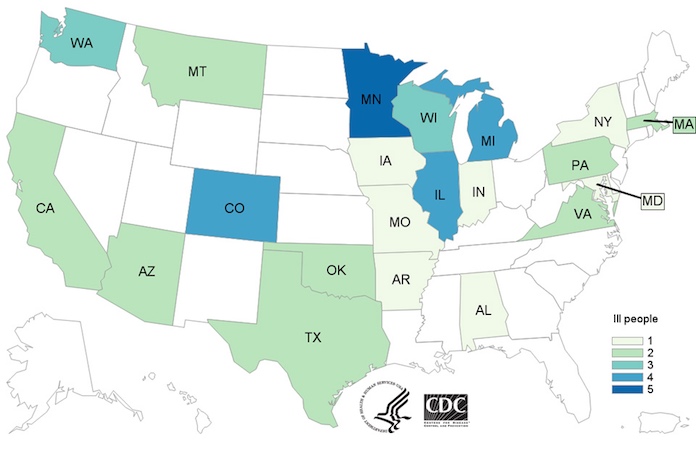The CDC has announced that the multistate outbreak of Shiga toxin-producing E. coli infections linked to recalled General Mills flour has grown to include four more patients. Now 46 people in 21 states are sick. One person has developed hemolytic uremic syndrome (HUS) as a complication of their illness. General Mills has expanded its recall of flour products to include more production dates. To see all of the UPC numbers and “Better if Used by” dates of the recalled flour products and products containing the flour, please see “General Mills E. Coli Flour Roundup.”

The most recent illness started on June 25, 2016. An infection with another serotype of E. coli O26 has been added to the outbreak investigation. The Shiga toxin-producing E. coli (STEC) bacteria O26 was isolated from a sample of General Mills flour. That is a different serotype from the original E. coli O121 in the first outbreak announcement.
The case count by state is: Alabama (1), Arkansas (1), Arizona (2), California (2), Colorado (4), Iowa (1), Illinois (4), Indiana (1), Massachusetts (2), Maryland (1), Michigan (4), Minnesota (5), Missouri (1), Montana (2), New York (1), Oklahoma (2), Pennsylvania (2), Texas (2), Virginia (2), Washington (3), and Wisconsin (3). Illnesses began on dates ranging from December 21, 2015 to June 25, 2016. The patient age range is from 1 year to 95 years, with a median age of 18. Eighty percent of ill persons are female. The unusual median age is explained because teenagers are more likely to consume raw dough, especially raw cookie dough, than adults.
Thirteen of those sickened have been hospitalized because their illnesses are so severe. One person has developed hemolytic uremic syndrome, a type of kidney failure. No one has died.
Any illnesses that occurred after June 29, 2016 may not be reported. It takes up to 3 weeks between the time a person becomes ill and when they are diagnosed and the illness is reported to the government.
In July 2016, lab tests by the FDA and General Mills found STEC O26 in a sample of General Mills flour. Whole genome sequencing (WGS) found that the bacteria isolated form the flour sample was closely related genetically to isolates from an ill person. The flour tested was not included in the earlier recalls, so the recall was expanded on July 25, 2016.
The symptoms of an E. coli infection include nausea, vomiting, a mild fever, severe abdominal cramps, and diarrhea that may be watery and/or bloody. Symptoms usually start three or four days after exposure to the pathogenic bacteria. Most people recover within a week or so, but some become so ill they must be hospitalized.
A serious complication of an E. coli infection, called hemolytic uremic syndrome, or HUS, can occur when a patient is incorrectly given antibiotics for this infection. Small children are more likely to spontaneously develop HUS when they are sick with E. coli. The symptoms of HUS include fever, lethargy, abdominal pain, little or no urine output, pale skin, irritability, bleeding from the nose or mouth, a skin rash, and bruising. If anyone is experiencing these symptoms they should be taken to a doctor immediately.
The long term complications and effects of an E. coli infection can be serious. HUS patients may suffer from kidney failure, seizures, or strokes. Patients also have an increased risk of developing high blood pressure, kidney damage, and cardiovascular disease. If you have this infection, it’s important that your doctor know about it so it can be noted on your chart in case any of these complications develop in the future. Annual follow-up medical visits are important for any E. coli patient.





Is there a number so can check if we have a bag.
There are, unfortunately, many numbers of recalled products. You can see them all here: https://foodpoisoningbulletin.com/2016/general-mills-e-coli-flour-recall-roundup/